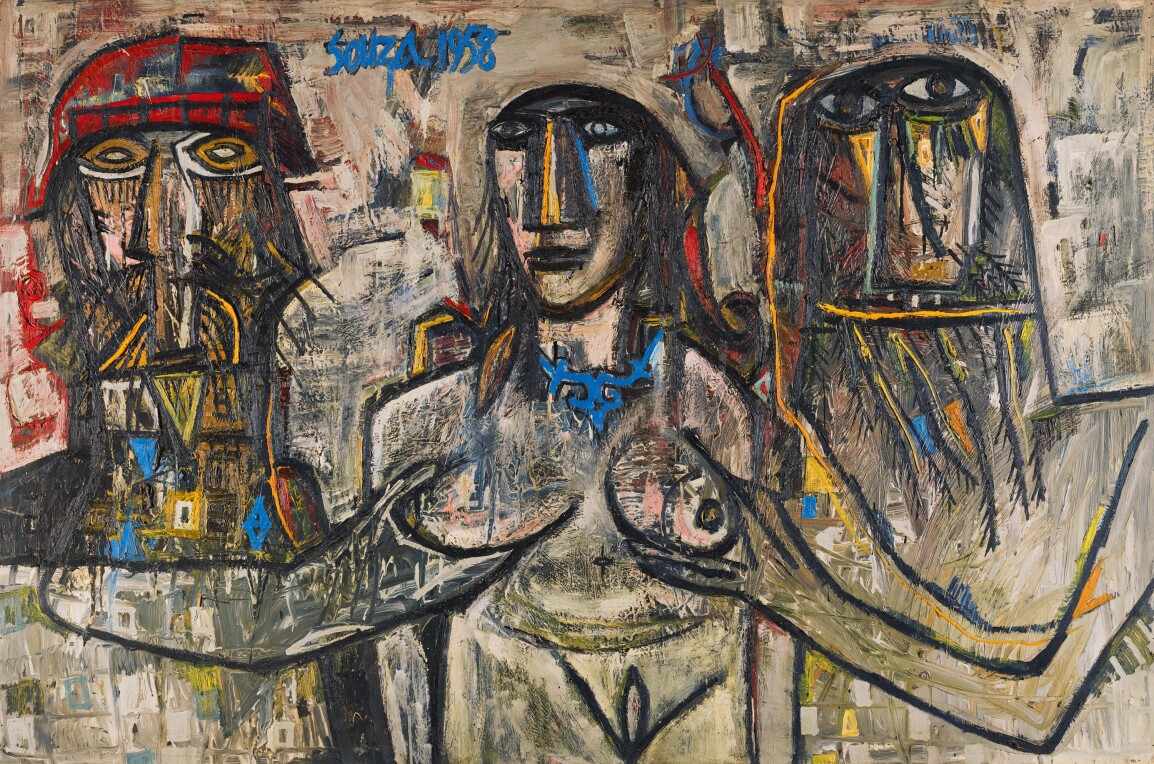The Ferocious Presence of Souza’s ‘Susanna and the Elders’
"We steal clandestine pleasures by the score,
Which, like dried orange rinds, we pressure tight."
— Les Fleurs du Mal by Charles Beaudelaiare (tr. William Aggeler)
T
he original book of Daniel does not include the story of Susanna and the Elders, and for Protestants the story remains apocryphal. Nonetheless, its theme of lust and betrayal, justice and faith has resounded with artists for more than five hundred years.
My mother told me something that defined my father's lifelong attack against the Church and her clerics. As a boy he was sodomised by a priest. When he told his mother, Lily, she could not believe him, so powerful was the Catholic faith back then that priests were emblematic of Christ on Earth. It was a profound betrayal on my grandmother's part, but explains why my father, both painter and man, identified with Christ's suffering and betrayal yet reviled the Church and her priests.
"Renaissance painters painted men and women making them look like angels. I paint for angels, to show them what men and women really look like"
Verse 9 of the apocryphal chapter reads: "And they perverted their own mind, and turned away their eyes, that they might not look unto heaven, nor remember just judgments."
Under the painting The Cardinal in the Mullins' monograph, Souza wrote: "Renaissance painters painted men and women making them look like angels. I paint for angels, to show them what men and women really look like." (FN Souza quoted in E. Mullins, Souza, Antony Blond Ltd., London, 1962, p. 82)
Two elders, their withered flesh like dried orange rinds, grip Susanna's breasts with vice-like hands. Through peephole eyes they ravage her entire form. Victor Musgrave observed: "The way the nude has been squashed up to get the cunt inside the picture edge does look a bit forced". (Letter to FN Souza, 1958, courtesy of Grosvenor Gallery). But that was the point. Susanna wedged; her cunt (from Latin cuneus, wedge) squeezed by unholy men. This painting was made for angels.
Souza's art is simultaneously magnetic and difficult to live with. It lays bare the underbelly of every human desire that contradicts Plato's ideals of beauty, goodness, truth, reminding us that we are all secretly voyeurs of the taboo.
Known to endow his female figures with the fullness of India's high-breasted goddesses—a form of female beauty that fuelled his art and libido from a young age—Susanna is transformed into what her accusers have made her. Polluted. Boxed. Misshapen. Limbless. Once golden skin now leaden with their lasciviousness. Right pupil blown. Above the left, thick globs of paint squeezed from the tube...Christ's crown of thorns pressed hard into her flesh.
When I first saw the work, I was immediately struck by its departure from what Victor Musgrave called "your ice-cold precision which makes your best pictures look inevitable." Was this anomalous painting a Souza milestone? If so, where would it stand in his oeuvre?

Birth (1955), while epic in size, and an important juncture in the artist's journey, remains fundamentally traditional in style. It marked an arrival. Its central figure, Mother India, is about to give birth to her (only begotten) son...once golden flesh greyed by his six-year struggle in the grim reality of post-war Britain...its iconography the "murals I painted on the walls of my mother's womb".
Souza's solo show at Gallery One that year vindicated years of struggle in a hostile environment. London's cognoscenti had finally acknowledged his importance in British and Indian art. He had arrived. But if an artist is to evolve, every arrival demands a new departure.

The (Susanna) painting is a radical departure from everything that came before. It foreshadows a complexity and chaos that would define his style in the 60s. In that decade, his personal life, along with the rest of the world, became increasingly layered. Orange Head (1963) is that painting's progeny. Without his experimentation there, he could not have painted a work with both the control and chaos that the Head displays.
It is possible that my father knew on a subliminal level he was about to take an evolutionary leap from everything he had previously believed his work to be, and follow a trajectory that would define his journey over the next forty years. That may account for his belief when he told Musgrave the painting was "probably [a] masterpiece".
Shelley Souza is a writer and the daughter of Francis Newton Souza and Maria Souza
She is an administrator of the FN Souza Estate.








